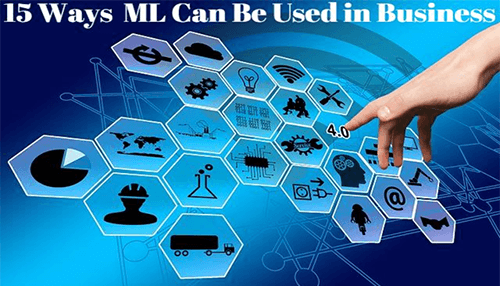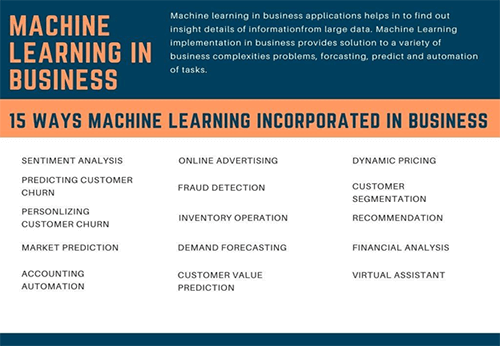What is machine learning?
Machine learning(ML) uses statistical methods to interpret data to find out the critical information for decision-making. Machine learning generates similar patterns, predicting, forecasting, and clusters the past depending on the user’s requirement.
Types of ML
Machine learning is divided into two major types: Supervised learning and unsupervised learning.
Supervised ML
Supervised ML works on statistical techniques such as regression to train past data and predict or forecast the future. Such as demand for inventory can be forecasted using ML regression.
Unsupervised ML
In unsupervised ML, data is not labeled and data features are not named; unsupervised learning uses methods of classification and clustering of data. In classification, we classify data into different groups, while in clustering data is clustered into different similar clusters to analyze.
Why Machine Learning in Business?
Machine learning model management applications in business are very broad as it help predict the dynamic price of the product to forecast data for the supply chain manager. It provides the business scalability, processing power, and a modern method of analytics.
The use of ML in business analytics has occupied various fields and many positions. The major reasons are higher volume, data availability, and fast processing. Businesses are now making profit by use of ML and implementing it in their systems to compete.
Machine learning in business The major application in business is to assist in extracting information and knowledge from massive data sets. Such as selecting 100 loyal customers from the million customers of a bank. However, if the ML algorithm is implemented correctly, it helps to solve complex problems and predicts customer behaviour.
15- Ways Machine Learning can be incorporated in Business
There are enormous applications of Machine Learning in every field and business. Machine learning is booming at a fast pace. Here, we discuss how ML can be incorporated in different businesses and give profit to them and make their work easy. 15 ways or applications are discussed below
1. Sentiment Analysis
ML can predict the customer feeling by examining the past data easily. Such as when a customer was buying some specific product or brands from the past many months and suddenly stopped and bought some other brands. The company can grab the customer again through many tactics such as discounts, improvement in packing and quality, product size, etc.
2. Predicting Customer Churn
ML can also help companies to understand the cost of different products bought by the customer and predict the retaining customers. They can also calculate the average revenue generated by the customer before churn.
3. Personalizing Products
Companies usually look for customers’ various buying habits and needs that can be easily seen using machine learning customer segmentation and personalization.
4. Market Prediction
Machine learning is very helpful in Market forecasting by considering market features such as revenue, domestic and international environment, investors interests, government policies, etc. Machine learning algorithms are powerful in prediction due to the consideration of hundreds of features simultaneously, while humans cannot do that.
5. Accounting and Finance
The biggest benefit that ML has given in Finance and accounting is automation. Now data entry and automation of reports are very easy. This task took a lot of time in the past and it was difficult to find mistakes.
6. Real-time Advertising
Digital marketing has left television and other platforms of advertisements. Online advertisements on different social media platforms are generated using ML algorithms. The user who is interested in Football, Facebook, or other social media places uses that knowledge and ads about football matches and related using ML.
7. Fraud detection
Machine learning is a beneficial technique in the deduction of fraud and spam. It works on the past data of customers and detects fraud. For example, a user does a transaction of a few hundred dollars from a bank on an ATM monthly. But if he starts doing a million transactions in a month, ML algorithms alert the system for checking.
8. Inventory Management and Optimization
Machine learning helps supply chain managers predict inventory required for the future by analyzing the past data. For Example, if a store manager has to order sweaters for winters, he can take help from ML models to exactly forecast the product.
9. Demand Forecasting
Demand forecasting is applied everywhere in the business such as supply chain, work force , e-commerce, and transportation. The historical data is learned and predictions carried out for the future.
10. Recommendation Systems
Recommendation systems are the most used tool in the business, Netflix to amazon all are gaining a lot of profit due to these machine learning based recommendation systems which predict customer choice exactly.
11. Dynamic or demand pricing strategies
Businesses use historical data, market conditions, product demand and supply gap in the market to predict dynamic pricing of some products. Such as umbrellas have no usage in the dry season and its price is low in the dry season, but in the rainy season, its demand is higher and prices also fluctuate.
12. Customer segmentation
Customer segmentation using ML models helps businesses to provide their valuable users with quality products in appropriate areas. Customer segmentation also helps in planning and predicting inventory.
13. Customer Lifetime Value Prediction
Machine Learning and data analytics techniques assist companies in predicting purchase patterns, selection of products, etc. These customer patterns can easily be used for predicting valuable customers for the business.
14. Virtual Assistant
Virtual assistants or chatbots provide customers 24 hours unlimited service and there can be thousands of customers at a single time with the capability of finding answers from large company databases.
15. Revenue and Profit Optimization
Machine learning techniques helped stores and businesses for revenue optimization and price selection by training on past data. It helps to reduce expenditures by giving us knowledge about expenses from data patterns.
Conclusion:
There is very big room for machine learning in business in almost every subfield of business. Businesses are using it for revenue generation and optimization, prediction, forecasting, and advising. However, getting started on using ML for more difficult business processes like data analytics, marketing automation, and the like can be daunting at first, so it’s worth consulting an expert before you get started. Overall, ML is a superb business asset when done correctly, even if most ML techniques are based on the past data of the customer.




